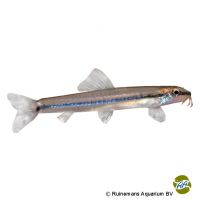Nemacheilus binotatus (Nemacheilus binotatus)
| Nemacheilus binotatus Nemacheilus binotatus | |
|---|---|
| Name | Nemacheilus binotatus |
| Name Lat. | Nemacheilus binotatus |
| Family | Stone Loaches |
| Family lat. | Nemacheilidae |
| Order | Carps |
| Order lat. | Cypriniformes |
| Origin | Thailand |
| Habitat | Streams, rivers |
| Diet | Omnivore |
| pH | 6.0-7.5 |
| Behavior | Peaceful |
| Keeping | Group |
| Care Level | Moderate |
| Reproduction | Egg scatterer |
| Breeding | None reported |
| Life Span | N/A |
| Protection | No |
| Metric Units | |
| Size | 5 cm |
| Temperature | 23-26 °C |
| Hardness | 2-12 °dH |
| Aquarium | ~ 100 l |
| US Units | |
| Size | 2" |
| Temperature | 73-79 °F |
| Hardness | 36-214 ppm |
| Aquarium | ~ 25 gal |
Distribution and habitat
The distribution area of the Arrow Loach is the Chao Phraya and Mae Khlong river systems in Thailand. They live in moderately flowing streams and rivers with sandy bottoms, among roots, stones and foliage.
Maintenance
The aquarium should have a dense planting, with many hiding places (roots, stones, caves), sufficient swimming space and a weak current. In order not to injure their barbels when foraging and digging, a fine-grained substrate (sand, round gravel) is ideal, which can be covered with some foliage (e.g. sea almond leaves).
No ammonia, ammonium and nitrite should be detectable, the nitrate value should not exceed 100 mg/l. To ensure the water quality and oxygen content, a filter and heater adapted to the aquarium size is required, as well as lighting for the species-appropriate day-night rhythm of the animals.
Diet
They feed mainly on insects, small crustaceans and microplankton. The food supply consists of live, frozen and dry food. For a balanced diet, feed once daily with a high quality sinking dry food (granules, pellets, food tablets) as well as cyclops, daphnia, artemia, mosquito larvae and plankton (live or frozen). In addition, they also need some vegetable food, such as algae leaves or dry food with high vegetable content (e.g. kelp, spirulina).
Only feed as much as will be eaten within a few minutes. A regular and varied diet promotes health and increases resistance.
Behaviour and compatibility
They are peaceful and sociable fish that can be socialized well with other peaceful fish. At least 5 Arrow Loaches should be kept together. Animals kept singly remain skittish and shy. Basically, only compatible fish species with similar requirements for water conditions and water temperature may be socialized.
Sex dimorphism
The females are slightly larger and more plump than the males.
Reproduction and breeding
There are no known reports of successful breeding in the aquarium.
Important
They often swim in groups of 10-20 animals. This behavior is very unusual for the genus Nemacheilus, as they usually live solitary under stones and roots.
The well-being of the fish should be checked regularly. Temperature should be checked daily, pH, hardness and nitrate levels should be checked at least every 14 days. Regular partial water changes are recommended, even if the contaminant level has not yet reached the upper limit. Sudden changes in water quality should be avoided. Newly introduced fish must be accustomed slowly to the water in the aquarium.
Further literature can be found in your pet store.
References
Text: petdata; Image: Ruinemans Aquarium B.V.
Source: BMELV (1998): Tierschutzgutachten - Haltung von Zierfischen (Süßwasser); RIEHL & BAENSCH (2004): Aquarien Atlas Bd. 3, Mergus Verlag; ENGELMANN (2005): Zootierhaltung - Tiere in menschlicher Obhut: Fische, Verlag Harri Deutsch
- Gemäß Tierschutzgesetz idgF
